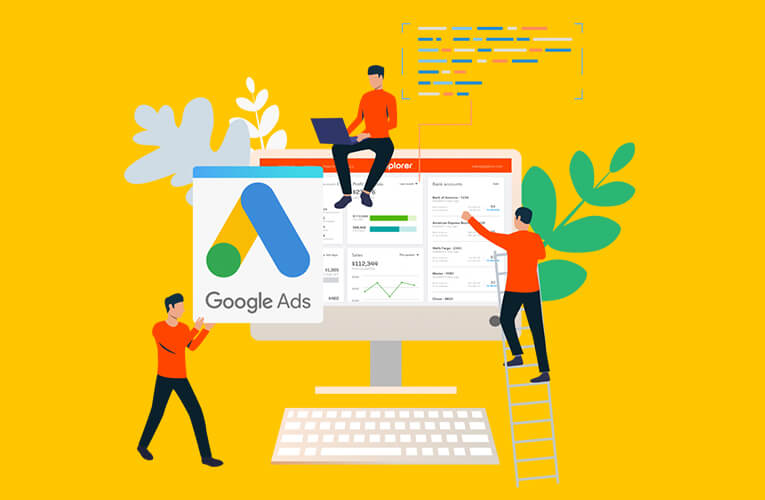There are 2.3 million Google searches per second, and Google ads are used on the majority of search results pages. For companies, Google advertising can be an extremely efficient means of transport to your website through appropriate, eligible means, exactly when people look for the kinds of goods or services that your company provides.
Google Ads
Through using Google Ads or publicity ads that appear on other websites through the Display Network and Google AdSense service, Google provides paid advertising which appears on Google.com’s search results.
Google ads are the online publicity service of Google. You can create online advertisements using Google Ads so that people can access the goods and services you sell when they are interested.
- Google Ads is a tool you can use to promote your business, to help sell goods and services, to increase public awareness, and increase website traffic.
- The online administration of Google Ads accounts allows you to build and modify your ad campaigns, including your ad text, your settings, and your own budget.
- There are no minimum commitments to spend, and your own budget is defined and controlled. You select the location for your announcement, set a budget that is convenient for you, and calculate the effect of your ad easily.
Google also provides display ads on the Google Display Network. A large group of external websites that cooperate with Google to deliver Google advertising, The Display Network is a website of third parties. Google Display Network ads can be placed in rich media formats, including text, images, video, and media, and can be targeted differently. It contains banner advertising and remarketing.
Why Google Ads Appear
The auction for Google Ads focuses on keywords – marketers choose a list of keywords that match their business offers, the terms that people use most when seeking their product. They then depend on these keywords to determine what they are prepared to pay for Google users to click on their advertisement. In combination with Google’s quality score based on the quality of your proposed ad, this tender will decide which advertisements are listed by Google on the SERP. The advertiser pays a certain fee while clicking on announcements (cost per click or CPC), which is calculated in the following formula:
| Competitor Ad Rank | +.01 = Actual CPC |
| Your Quality Score |
This is where the term Pay-Per-Click (PPC) originates.
The Google Ads Auction
Google Ads operates on an auction scheme, which occurs each time a user searches for a keyword.
You need to maximize your Quality Score and the quotation number in order to “win” your Google Ads Auction and see your Google ads appear for keywords. In addition to the bid number, the higher your Quality Score, the better your ad placement.
The following factors (among others) affect your Quality Score:
- The relevance of your Google ad to the search query
- The relevance of the Google keyword to your ad group
- The relevance of your ad to its landing page
- The historical click-through rate (CTR) of the ad and its ad group
- Overall historical account performance
There are also overall benefits to having a high-quality score:
- Lower costs– Google rewards advertisers with high-Quality Scores by lowering their cost per click (CPC), helping improve ROI.
- Higher exposure – If high-quality scores are available, your ads appear more frequently, in better places, in the SERP – the top versus the bottom of your list. You will get more conversions and clicks without raising your quotes.
Google Ads Costs
Google’s costs vary according to a variety of variables, including your keywords and industry’s competition, geographical position, the nature of your advertising campaigns, and more.
For Google search advertising in all industries in the United States, the average cost per click is $2.32. The average prices of Google Ads are also much lower than in other countries.
Google Ads Budget
Budgeting has always been a chore. If you pinch cents to rend an overpriced studio with a view of a narrow alley or pave the way for a website maguldom or both, the average red-blooded American drives up the wall.
There are ways to alleviate the folly. However, there is no way to avoid budgeting properly without being stuck on the lane. This is particularly true of Google ads, formerly Google AdWords, which shows either business growth or the fact that every click is your hard-earned cash.
Sadly, there are scant resources that take a comprehensive approach to the budgeting of PPCs. No free app is available. No serious voucher. It just needs to be grasped.
We have put together the following guide to help you learn the right budgeting plan for Google Ads from the ground up. It is divided into three parts that are easy to digest:
- Determining your initial Google Ads budget.
- Allocating spend across campaign types.
- Introducing new campaigns.
Do you have some hate of the past budgeting and reading necessary? Fret not. Each segment has been condensed into a handful of bullets.
Part 1: Determining your initial Google Ads budget
You have gained knowledge about your credit card and financed your account. You only downloaded Google Ads Editor (spewing from your desktop is still hoped for by steam). What now?
The amount of money you intend to spend in the first quarter must be determined. Month. Week. Day. Hour. No. Your first click.
When assessing your initial Google Ads budget, you have four main questions to ask yourself:
- How do Google Ads fit into my current marketing strategy?
- What (and where) are my competitors spending?
- How much are the CPCs (costs per click) for the keywords I’m bidding on?
- Which KPI (key performance indicator) matters most to me?
You will be able to dive into campaign forms, optimize and ultimately expand until replied. Let’s hop into these questions with that in mind.
How do Google Ads fit into my current marketing strategy?

If your company is an important part of the local community or if you have a well-established online presence (you are a thoughtful pioneer in transporting organic traffic to your platform with a fantastic SEO and even greater input). Conversely, an emerging company may do something similar with an uncomfortable social tracking with its finger on the pulse of its target public. This organic traffic is “free” apart from the time and wages of everyone who is leading this initiative.
Consider the other marketing platforms you use to expand your brand. Billboards. Ephemera. Purchased leads. Radio spots. Bench ads. Commercials. Events. Branded urinal cakes?
List and engrave the following for each marketing channel you use: Is your Google Ads account the objective of supporting or substituting existing efforts (to provide people with a way to use their gift code)?
What (and where) are my competitors spending?
Google the name of your company. Go on, I’m going to wait. What do you see in the SERP top now?
If you’re not new to Google Ads, it’s best to respond “my optimized advertising.” If you’re a newcomer, a better will put your rivals on the computer.
In addition to their advertised keywords, you can use a tool, like the Keyword Planner or the SEMRush to gain an idea about where your rivals use their Google Advertising budgets (I don’t think about the qualitative details available but keyword lists and sample ads can be of value).
Based on this information, you can build a strategy to remove your ads from the SERP, and no one has been intelligent enough in finding (cheaper) keywords before you arrived.
How high are the CPCs for the keywords I’m bidding on?
The resources I touched upon just now? Again, bust ’em. The most basic way of determining a budget is to take into account the costs of the keywords that you give.. Do you just use this knowledge to set up a budget? Not absolutely. Absolutely not. But this is a good point of departure.
Go to the Google Ads Keyword Planner and enter one of the pages on the left. Set the remaining parameters (industry, place, avoidance terms, etc.) accordingly and brace yourself for scrolling through the pages of prospective keywords alongside their relative popularity and competition.
Try the same thing with the page that matches any good or service you sell. These undervalued search terms would certainly be uncovered for you to submit an offer. Ideally, you’re looking to find as many low-competition high-speed (which also convey business purposes) terms as possible. This is your sweet place. This is yours.
In a little time, we’ll go further on this, but it ends up: Keywords that are more likely to convert than ones that do not show urgency or familiarity. More intentional than competitive keyword is conveyed by a marketed keyword. “Limo from Logan to Nashua at midnight,” even though the search volume is slightly smaller, is much more urgent (and therefore valuable) than “limo service.”
Which KPIs (key performance indicators) matter most to me?
For the last time, we saved the most critical problem. A KPI is a value that measures the efficiency of a company or individual gauge. Not all companies think for the same.
Some believe that the CPA is the all-embracing thing. How many kick-offs start with costs per purchase taken from thin air I can’t tell you. If you are certain that this is your KPI, set a logical target. If your style is more practical, you can see how many conversions monitored by Google Ads (RIP converted clicks) you take in the mean to make your actual CPA a good customer. They can also exploit your current CPA on other platforms, achieve your paid search objective, and match up or down as soon as more account information is available.
Many other KPI companies are using Google Ads as barometers for active promotions. If you are unsure of which performance metrics are the best for your company here are some tools to start:
- Metrics of Google Ads: How to Sense The PPC Information – KPIs include impressions share, clicks and CTR, CPC, CPA, and wasted Budget in an important overview of Google’s primary advertising.
- Simple Newbies & Math Haters Bidding Strategies by Google – Includes policies and formulas for the initial Google advertising bids and the determination of the CPA.
- Google Ads: Google Ads Winning – Larry Kim’s approach to optimizing performance by quality score. Google Ad.
After these four main questions have been answered, check out your results. You’ll want to think about the KPIs you measure your success and how numerous sales and leads you are seeking to get from Google Advertising in order to decide your ideal budget. Consider the other marketing platforms that you use and try to use any related targets that you have set as the starting point for Google ads. Finally, take account of the expense of keywords you probably give, by looking at those that are already selected by your rivals (and not).
Notes
- To notify your Google Ads account layout and budget, use the data from current marketing efforts.
- Use competitor analytics and keyword research to minimize and get to work the learning curve.
- Determine your budget by setting the KPIs that are most important to your company and retrofitting your profitability figures.
Part 2: Allocating spend across search campaigns
Every search campaign in Google ads will generally fall into one of the five categories: research, branding, competing, high-intention, and top performers. Each of the names is mixable; some of them are very flexible.
Logic says that your budget should be mostly funneled to your keywords, but what about the rest?
Research-stage/top-of-funnel keywords
More often than not, a new pay quest person will develop campaigns aimed at high-end conditions. For instance, an entrepreneurial and misinformed personal injury lawyer will apply to a “personal injury lawyer.” Makes sense, right?
Sadly, these keyword forms cost an arm and a leg in most industries. Google suggests an offer for the above term of just over $97. And per click, that’s it. Yikes. – Yikes. Of course, to make a point, I chose this keyword. Does the sky-high CPC vertical rife? Perhaps. But it isn’t even the biggest problem with such keywords: it’s intended.
Branded keywords
The use of advertised words is frequently challenged for some unintelligible purpose. That’s poppycock.
Even though it should be the first item that appears in organic results when someone searches for your company, over the organic listings your competitors can argue, if you don’t, there’s a big old chunk of real estate.
Consider this, if my testimony is not enough to persuade you. Concurrents have to pay a premium to bid on your brand, but the CPCs you see are much cheaper for the same terms. Your copy of your domain and landing page is hyper-related to the keywords, which results in maximum quality values and lower costs.
In short, although the only ones that you are offering are not branded words, it is essential to allocate expenditure to ensure the dominance of SERP.
Competitor keywords
Remember all of the branded words I said? The same is true when it comes to offering your rivals. As you did with the high-end word, so that you don’t blow the budget into search queries that won’t ever change, you want to use analysis and good sense.
When they start ads on rivals, one major error is that of tendering the wrong competitors. In general, make sure you choose companies you really compete against when you choose rivals for an offer. Select competitive advantages for your rivals, regardless of whether they are better offers, bigger supply or something. In other words: don’t be like fantasydraft.com
High-intent keywords
When the most common phrase is (mostly) a wild chase of goose, the most intentional keywords are golden eggs that fall into your lap.
Two flavors have been given high-intention keywords: “buy now” and “product.” You want to make sure you use the largest part of your search budget to bid keywords in one of these categories (bonus points if you can unearth search terms that live somewhere in between).
Keywords “Buy now” are those which, broadly, suggest that your product or service is ready to trigger. They did their homework (or a trusted trustee referred to them) and it’s time to shop now. Usually the keywords of “buy now” consist of funnel words with words such as:
- Buy
- Discount(s)
- Deal(s)
- Coupon(s)
- Free shipping
Top Performers

When you run your Google Ads at least 30 days before you start, you get an idea of what keywords your money is worth and what they are not. The middle terms — which your advertisements constantly demonstrate but never seem to get clicked — are an opportunity. Concentrate your efforts on these keywords to create a perfect ad copy. Make the landing page modifications. Check the triple extensions for your ad. If you still have no clicks after a few weeks (or worse, clicks but no changes), put them in the chopping block. If not, put them on a chopping block.
By putting your high-performance keywords into their own campaigns, you give more control over how much you spend on historically well-accomplished keywords. The benefits? The single converting keyword in an ad category is no longer bundled with twelve other keywords that just siphon off your budget.
An alert phrase, however: you are lost if you remove a keyword from your original ad group. Since it’s relatively new in the situation described above, moving underperforming keywords to new campaigns makes better sense.
Notes
- Focus on highly intentional keywords for the majority of your budget (including branded terms).
- Top of the Funnel keywords may eat a hole in your wallet: better (best) ways of reaching a broad audience are available.
- To ensure a full ROI, adjust budget allocation on a weekly basis.
Part 3: Budgeting For Everything Else Google Ads Has To Offer
Search is the backbone of most Google Ads accounts, but advertisers also have several other choices on the platform: display and commenting (usually through display, though remarketing on search can also be effective). There’s shopping, of course, as well, but this is a post for itself.
These alternatives may supplement or fully replace conventional search ads, depending on your vertical position. Whatever the way you spend your money on Google Ads, they can have a dramatic effect. Take a closer look. Let’s look closer.
Display
The clicks are cheaper than on conventional searches, but the Google Display Network’s worth it because of the big decrease in direct conversions? The short reply is yes. Oh, yeah, twelve times.
Remember the old intentions of our pal? Ok, people seeing your advertisements do not have much of it when you are using the GDN. It is more close to conventional ads (think signs) than to searching, with the additional advantages of improved focusing and on-demand analysis.
In addition to remarketing, the Display Network has three key functions: brand recognition, presentation of the product, and the support of a long sales process, and offers a wide variety of targeted choices. It must be fishing, right?
The lack of transformation attributable directly to GDN, particularly for small companies with limited budgets, can make it difficult to justify. That said, without letting money on fire there are ways to dip in your toes.
I suggest starting with management placements or in-market audiences when I deal with customers trying to get the Display going. This gives you the opportunity to display innovative banners on some websites or to people whose browsing history shows that their preferences are consistent with what you sell.
Check out some of these other strategies and build on your display budget in order to construct the ideal network complementary strategy.
Remarketing
Let me start with this: when you run a business in e-commerce and you don’t have a dynamic comment (marketing advertising which displays website visitors the product or products they looked at on your website), follow this guide the rest of your day. Future, from on a stack of greenbacks, you can thank me.
But it’s true. Remarketing is a key part of Google Ads. Each vertical company will make use of it.
A simple way to estimate the percentage of conversions that come from returning visitors to a site and then spend the same amount on remarketing is calculated.
Notes:
- Remarketing is not an Option: optimize your budget by persuading more visitors to convert. It is particularly dynamic commenting.
- Let your display network do your dirty tasks in top-of-funnel so that a more qualified search budget can be saved.
A final word: Expanding to other platforms
Finally, your boot camp on Google Ads has come to an end!!
Your starting point has been identified. You have carefully allotted bread to your search campaigns and have started to increase your budget to include Google ads. Is the finger clamping index? Rub it with dirt. Rub some dirt. But you’re not done killing it.
Apart from constant optimization – essential for maximizing your paid search budget, you can build on other platforms. Although bing ads are the logical next move, Facebook ads (leading ads, anybody?) or LinkedIn (but possibly Facebook) might be a good way of banging your buck, too.












